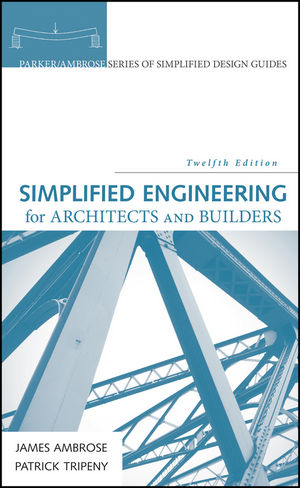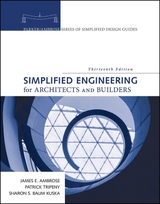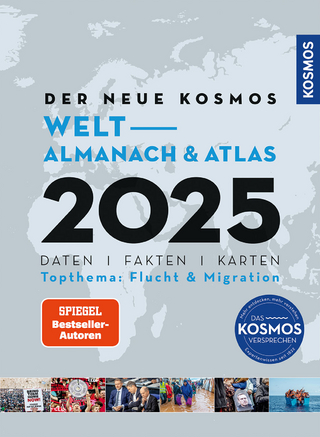
Simplified Engineering for Architects and Builders
John Wiley & Sons Inc (Verlag)
978-1-118-97504-6 (ISBN)
- Titel erscheint in neuer Auflage
- Artikel merken
The bestselling structural design reference, fully updated and revised Simplified Engineering for Architects and Builders is the go-to reference on structural design, giving architects and designers a concise introduction to the structures commonly used for typical buildings. The clear, accessible presentation is designed to give you the essential engineering information you need without getting bogged down in excess math, making this book an ideal reference for busy design professionals. This new 12th edition has been completely revised to reflect the latest standards and practices. The instructor site includes a complete suite of teaching resources, including an instructor's manual.
Structural design is an essential component of the architect's repertoire, and engineering principles are at the foundation of every sound structure. You need to know the physics, but you don't necessarily need to know all of the math. This book gives you exactly what you need without losing you in a tangle of equations, so you can quickly grasp and apply the material.
Understand fundamental concepts like forces, loading, and reactions
Learn how to design for wood, steel, or concrete construction
Study structural design standards and develop sound structural systems
Determine the best possible solutions to difficult design challenges
The industry-leading reference for over 80 years, Simplified Engineering for Architects and Builders is the definitive guide to practical structural design.
JAMES AMBROSE is Editor of the Parker/Ambrose Series of Simplified Design Guides. He practiced as an architect in California and Illinois, and as a structural engineer in Illinois. He was a professor of architecture at the University of Southern California. PATRICK TRIPENY is the Director of the Center for Teaching and Learning Excellence and is a Professor of Architecture at the University of Utah. He teaches the architectural structures sequence in the School of Architecture and the graduate design studio. He is the recipient of several teaching awards including the ACSA/AIAS New Faculty Teaching Award in 2001 and the University of Utah's Early Career Teaching Award in 2000-2001.
Preface to the Twelfth Edition xi
Preface to the First Edition xv
Introduction xvii
Part I Fundamental Functions of Structures 1
1 Investigation of Forces, Force Systems, Loading, and Reactions 3
1.1 Properties of Forces 3
1.2 Static Equilibrium 7
1.3 Force Components and Combinations 8
1.4 Graphical Analysis of Concurrent Force Systems 13
1.5 Algebraic Analysis of Nonconcurrent Force Systems 17
1.6 Laws of Equilibrium 21
1.7 Loads and Reactive Forces 24
1.8 Load Sources 28
1.9 Load Combinations 40
1.10 Determination of Design Loads 41
1.11 Design Methods 43
2 Investigation of Axial Force Actions 47
2.1 Forces and Stresses 47
2.2 Deformation 51
2.3 Suspension Cables 56
2.4 Funicular Arches 61
2.5 Graphical Analysis of Planar Trusses 64
2.6 Algebraic Analysis of Planar Trusses 73
2.7 Cable-Stayed Structures 80
2.8 Compression Members 83
3 Investigation of Structures for Shear and Bending 86
3.1 Direct Shear Stress 86
3.2 Shear in Beams 87
3.3 Bending Moments in Beams 91
3.4 Sense of Bending in Beams 98
3.5 Tabulated Values for Beam Behavior 105
3.6 Development of Bending Resistance 109
3.7 Shear Stress in Beams 113
3.8 Continuous and Restrained Beams 117
3.9 Members Experiencing Compression Plus Bending 132
3.10 Rigid Frames 142
3.11 Buckling of Beams 150
3.12 Second-Order Analysis 153
3.13 Computer Software for Structural Analysis 155
4 Structural Systems and Planning 157
4.1 General Considerations for Structural Systems 158
4.2 Shear Wall and Diaphragm Structural System 161
4.3 Braced Frame Systems 162
4.4 Moment Frame Systems 164
4.5 Wood Construction 166
4.6 Steel Construction 172
4.7 Concrete Construction 177
Part II Wood Construction 185
5 Wood Spanning Elements 187
5.1 Structural Lumber 188
5.2 Reference Design Values for Allowable Stress Design 189
5.3 Design Controls for Load and Resistance Factor Design 198
5.4 Design for Bending 200
5.5 Beam Shear 203
5.6 Bearing 204
5.7 Deflection 206
5.8 Behavior Considerations for LRFD 209
5.9 Joists and Rafters 217
5.10 Decking for Roofs and Floors 221
5.11 Plywood 222
5.12 Glued-Laminated Products 226
5.13 Wood Fiber Products 227
5.14 Assembled Wood Structural Products 228
6 Wood Columns 231
6.1 Slenderness Ratio for Columns 232
6.2 Compression Capacity of Simple Solid Columns, ASD Method 232
6.3 Column Load Capacity, LRFD Method 240
6.4 Stud Wall Construction 242
6.5 Columns with Bending 244
7 Connections for Wood Structures 252
7.1 Bolted Joints 252
7.2 Nailed Joints 254
7.3 Plywood Gussets 258
7.4 Investigation of Connections, LRFD Method 258
7.5 Formed Steel Framing Elements 259
Part III Steel Construction 263
8 Steel Structural Products 265
8.1 Design Methods for Steel Structures 265
8.2 Materials for Steel Products 267
8.3 Types of Steel Structural Products 270
9 Steel Beams and Framing Elements 276
9.1 Factors in Beam Design 276
9.2 Inelastic Versus Elastic Behavior 278
9.3 Nominal Moment Capacity of Steel Beams 285
9.4 Design for Bending 291
9.5 Design of Beams for Buckling Failure 296
9.6 Shear in Steel Beams 299
9.7 Deflection of Beams 305
9.8 Safe Load Tables 313
9.9 Steel Trusses 319
9.10 Manufactured Trusses for Flat Spans 320
9.11 Decks with Steel Framing 328
9.12 Concentrated Load Effects on Beams 330
10 Steel Columns and Frames 334
10.1 Column Shapes 334
10.2 Column Slenderness and End Conditions 336
10.3 Safe Axial Loads for Steel Columns 338
10.4 Design of Steel Columns 341
10.5 Columns with Bending 352
10.6 Column Framing and Connections 356
11 Bolted Connections for Steel Structures 359
11.1 Bolted Connections 359
11.2 Design of a Bolted Connection 371
11.3 Bolted Framing Connections 377
11.4 Bolted Truss Connections 379
12 Light-Gage Formed Steel Structures 383
12.1 Light-Gage Steel Products 383
12.2 Light-Gage Steel Decks 384
12.3 Light-Gage Steel Systems 389
Part IV Concrete Construction 391
13 Reinforced Concrete Structures 393
13.1 General Considerations 393
13.2 General Application of Strength Methods 400
13.3 Beams: Ultimate Strength Method 401
13.4 Beams in Site-Cast Systems 414
13.5 Spanning Slabs 429
13.6 Shear in Beams 435
13.7 Development Length for Reinforcement 449
13.8 Deflection Control 459
14 Flat-Spanning Concrete Systems 462
14.1 Slab-and-Beam Systems 463
14.2 General Considerations for Beams 470
15 Concrete Columns and Compression Members 475
15.1 Effects of Compression Force 475
15.2 General Considerations for Concrete Columns 479
15.3 Design Methods and Aids for Concrete Columns 489
15.4 Special Considerations for Concrete Columns 499
16 Foundations 505
16.1 Shallow Bearing Foundations 505
16.2 Wall Footings 506
16.3 Column Footings 514
16.4 Pedestals 522
Part V Structural Systems for Buildings 527
17 General Considerations for Building Structures 529
17.1 Choice of Building Construction 529
17.2 Structural Design Standards 530
17.3 Structural Design Process 531
17.4 Development of Structural Systems 532
18 Building One 536
18.1 General Considerations 536
18.2 Design of the Wood Structure for Gravity Loads 537
18.3 Design for Lateral Loads 543
18.4 Alternative Steel and Masonry Structure 554
18.5 Alternative Truss Roof 562
18.6 Foundations 564
19 Building Two 566
19.1 Design for Gravity Loads 568
19.2 Design for Lateral Loads 571
19.3 Alternative Steel and Masonry Structure 574
20 Building Three 577
20.1 General Considerations 577
20.2 Structural Alternatives 581
20.3 Design of the Steel Structure 583
20.4 Alternative Floor Construction with Trusses 592
20.5 Design of the Trussed Bent for Wind 596
20.6 Considerations for a Steel Rigid Frame 601
20.7 Considerations for a Masonry Wall Structure 602
20.8 The Concrete Structure 609
20.9 Design of the Foundations 632
Appendix A: Properties of Sections 635
A.1 Centroids 635
A.2 Moment of Inertia 638
A.3 Transferring Moments of Inertia 642
A.4 Miscellaneous Properties 646
A.5 Tables of Properties of Sections 649
Glossary 662
References 673
Quick Reference to Useful Data 675
Index 677
| Erscheint lt. Verlag | 16.2.2016 |
|---|---|
| Reihe/Serie | Parker/Ambrose Series of Simplified Design Guides |
| Verlagsort | New York |
| Sprache | englisch |
| Maße | 150 x 221 mm |
| Gewicht | 794 g |
| Themenwelt | Schulbuch / Wörterbuch ► Lexikon / Chroniken |
| Technik ► Architektur | |
| Technik ► Bauwesen | |
| ISBN-10 | 1-118-97504-9 / 1118975049 |
| ISBN-13 | 978-1-118-97504-6 / 9781118975046 |
| Zustand | Neuware |
| Informationen gemäß Produktsicherheitsverordnung (GPSR) | |
| Haben Sie eine Frage zum Produkt? |
aus dem Bereich



